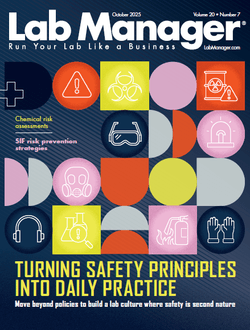
Dear Linda,
At the lab I manage, one of my staff recently spilled a good amount of a nonhazardous chemical on his benchtop and was uncertain as to how to clean it up. Someone else stepped in to remedy the situation and, luckily, there were no serious consequences. However, the incident was a wakeup call for me that my staff needed to be better trained to handle chemical spills as well as other potential hazards. Can you please suggest a starting point for reviewing our current lab safety training program in order to make some necessary improvements?
Thanks in advance.
Rene
Dear Rene,
With a research facility’s typical mix of laboratories, instrument rooms, chemical storage, and waste handling, hazards are always present. Every day, your staff must deal with these hazards while hopefully avoiding accidents and injuries. As you might imagine, well-trained employees do a much better job at this than average or untrained workers.
To develop an effective lab safety training program, begin by taking a hard look at your facility’s safety record. Pull all recent accident and injury reports and trace each to its source area. Don’t forget to include reports of near misses and close calls.
Your next step is to examine your current training model using the OSHA voluntary training guidelines. These seven guidelines will walk you through the entire process, from development to delivery, and then loop back through evaluating and improving your training programs. The seven guidelines are summarized here:
- Determine whether a safety problem can be solved by training
- Determine what training, if any, is needed
- Identify goals and objectives for the training
- Design learning activities
- Conduct training
- Determine the effectiveness of the training
- Revise the training program based on feedback from employees, supervisors, and others
It is clear in the mountains of literature and heaps of studies performed that the role of training is fundamental to developing and maintaining effective hazard avoidance. The issue is not whether safety and health training can reduce risks from workplace hazards, but rather determining how to maximize these training effects. Following the voluntary OSHA training guidelines will put you on a path to an excellent occupational safety and health training program.
Safety first!
Cheers,
Linda
For more info: www.labmanager.com/lab-hazards
Have a question for Linda? Email her at LINDA@labmanager.com












